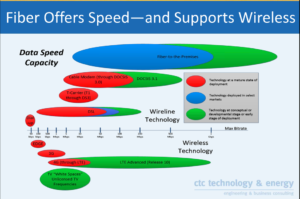 On March 31, 2017 Joanne Hovis, President of CTC Technology & Energy presented a webinar that chronicled the history of broadband- starting from the days of copper wires and progressing through today’s fiber optics and future 5G wireless connections. Hovis described how the technologies have impacted consumers and businesses alike through amazing storytelling and brings to life the birth and the future of broadband technology.
On March 31, 2017 Joanne Hovis, President of CTC Technology & Energy presented a webinar that chronicled the history of broadband- starting from the days of copper wires and progressing through today’s fiber optics and future 5G wireless connections. Hovis described how the technologies have impacted consumers and businesses alike through amazing storytelling and brings to life the birth and the future of broadband technology.
Here is the diagram that Hovis used during her presentation:

Hovis’ discussion began with the advent of the commercial internet two decades ago. Beginning in 1995-96. Hovis showed us the humble beginnings of 50 Kbps dial up internet in the mid-1990s. That is substantially slower than technology today. She identified that there are 3 main markets that internet providers target:
- Residential Market
- Small/Medium Business Market
- Enterprise Market
The residential market is the market that most consumers belong to. Occasionally, the Small/Medium business market is grouped with the residential market due to size. The enterprise market refers to larger entities like schools, libraries, governments, hospitals, and other big dollar customers.
After describing the markets, Hovis went on to describe the advent of the dial-up era.
During the late 1990s, thousands of dial-up Internet Service Providers (ISPs) popped up, and there was a lot of commercial excitement. For those who are not aware, dial-up Internet was a form of internet that used telephone lines to deliver internet service. It was now that people started to recognize the emerging market. After dial-up, the birth of broadband internet started with the creation of the cable modem.
The major innovation that accompanied the cable modem was Data Over Cable Service Interface Specification, otherwise known as DOCSIS. This allowed connections to go 2 ways, which allowed cable systems to become an internet platform. This is key, because the cable system has a much more capable infrastructure than the copper networks of old.
Then, cable companies could use coaxial cables as a broadband medium. Coaxial cables are the wires that connect your modem to the other wires outside of the building. These coaxial cables gave the cable industry an advantage over the phone industry.
In response to this, the phone industry developed digital subscriber line (DSL) technology. Today, even the best DSL networks (with support) can get to decent broadband speeds. Though, few companies decide to fully commit to DSL adoption.
Hovis told us that DSL was not developed as a broadband technology. For phone companies to get faster speeds, they must abandon DSL and build more fiber. This means an entire infrastructure upgrade. Some telephone companies had started to do this, but then backed off due to costs.
The cable industry has a more capable medium/infrastructure. Hybrid fiber coaxial networks are vastly superior to the copper networks. The nature of how networks were built in the first place was a disadvantage to the copper networks. Video as a product was only though of as entertainment, so businesses typically did not purchase the video products.
When the cable networks were built they were built in residential and not in business areas. When cable became a source of broadband, some commercial districts did not have cable service and thus no access to cable broadband service. Small businesses suffer and “mom and pop” stores suffer from lack of broadband competition.
When cable networks were built, they were regulated by local governments and regulated. The cable industry had to build networks everywhere in a residential community with certain population densities, not just big profit areas. This was huge as it allowed many people in metropolitan areas to access to cable broadband service. If not for local governments and their “franchise agreements”, this would not have been possible. Hovis said that this was a positive benefit to the community and industry.
On the opposite side, cable modems and networks were rarely deployed in rural areas. Investments in small town networks have been poor compared to metro areas.
From an urban standpoint, Hovis says that the core challenge is the small business. It’s not something that is caught in mapping efforts. A lot of small businesses don’t have access to cable infrastructure, only DSL. The concern is a lack of continuing investment in DSL. If DSL is the only viable competitor to the cable modem service, it must be able to perform effectively. However, DSL networks are generally old and have not all been upgraded.
Hovis said that fiber theoretically has unlimited capabilities. It can expand to encompass as much bandwidth as necessary and currently, we even have 10 Gigabit per second (Gbps) products available in some places (though demand may not be there yet).
Fiber is not cheap. Google Fiber has slowed its expansion plans recently, but even so, Google’s pricing of a 1 Gbps service has become the benchmark price for similar services elsewhere. Google has made it so gigabit speeds aren’t costing thousands of dollars. Google has done one of the best things for consumers – create competition.
Hovis then transferred to the wireless side of the broadband issue. On the diagram, the green oval for LTE Advanced refers to many things, which are all hyped as the new 5G service. These are all technologies that are expected to emerge around 2020. These innovations are wireless, but will require fiber connections every block or every few blocks in some neighborhoods to function.
Competition is necessary for broadband prices to stay low. This is especially important for low income areas where broadband is not available and consumers are relying on mobile data services. The data caps that cellular providers impose on many contracts could be used up very quickly if videos are watched. Families could not use mobile data on a consistent basis due to this.
Potential mergers between phone and cable companies have been discussed. Hovis said that with our current administration, the FCC and Justice Department are likely to be friendlier to merger applications. Mergers between cable and phone companies could decimate competition, and not only that, but it could also decimate emerging competitions in the broadband marketplace.
Overall, Hovis gave a wonderful presentation on the past and future of broadband internet. I recommend that everyone watch her full webinar here.
